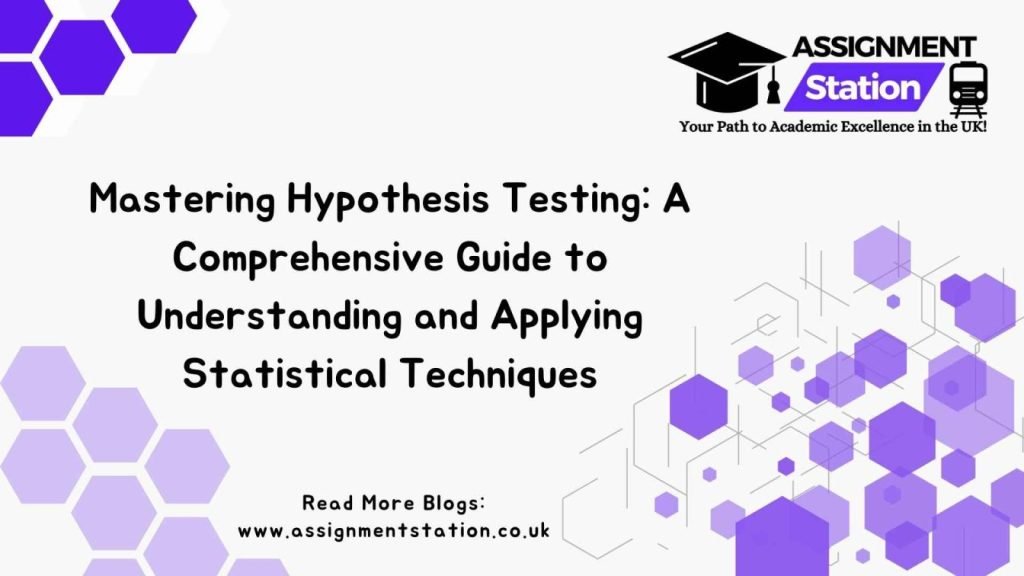Hypothesis testing is a crucial aspect of statistical analysis, offering a structured approach to determine whether your data supports a specific assumption or theory. In this comprehensive guide, we’ll explore what hypothesis testing involves, how to test a hypothesis, and why it’s essential for rigorous research. We’ll also provide clear examples to illustrate key concepts like the null hypothesis and statistical hypothesis. Whether you’re a student or a researcher, understanding these concepts is vital for drawing accurate conclusions from your data.
What is Hypothesis Testing?
Hypothesis testing is a statistical method used to evaluate the validity of a hypothesis about a population based on sample data. It involves making an initial assumption (the hypothesis), testing it with data, and deciding whether to reject or fail to reject the hypothesis. The primary goal is to determine if there is enough evidence to support a particular claim or theory.
Key Concepts in Hypothesis Testing
- Hypothesis: This is a statement or assumption that you want to test. It could be about a population parameter, like a mean or proportion, or a relationship between variables.
- Null Hypothesis (H₀): The null hypothesis is the default assumption that there is no effect or no difference. It serves as the starting point for testing. For example, if you’re testing a new drug, the null hypothesis might be that the drug has no effect compared to a placebo.
- Alternative Hypothesis (H₁ or Ha): The alternative hypothesis is what you want to prove. It represents the opposite of the null hypothesis. For instance, in the drug example, the alternative hypothesis would be that the drug does have an effect.
- Statistical Hypothesis: This refers to hypotheses that can be tested using statistical methods. They provide a formal framework for assessing the validity of your claims.
Steps in Hypothesis Testing
- Formulate the Hypotheses: Begin by stating the null and alternative hypotheses. Make sure they are mutually exclusive and cover all possible outcomes.
- Choose the Significance Level (α): The significance level, often set at 0.05, represents the probability of rejecting the null hypothesis when it is actually true. It helps determine the threshold for making decisions.
- Collect Data: Gather sample data relevant to your hypotheses. The data should be representative of the population you are studying.
- Perform the Test: Use statistical methods to analyze the data. This might involve calculating test statistics and comparing them to critical values or using p-values to assess the strength of the evidence.
- Make a Decision: Based on the results, decide whether to reject or fail to reject the null hypothesis. If the p-value is less than the significance level, you reject the null hypothesis.
- Draw Conclusions: Interpret the results in the context of your research question. Discuss whether the evidence supports the alternative hypothesis and the implications of your findings.
Examples of Hypothesis Testing
To better understand hypothesis testing, let’s look at a couple of examples:
- Example 1: Null Hypothesis Testing in Education Suppose a school wants to test if a new teaching method improves student performance. The null hypothesis might be that the new method has no effect on test scores (H₀: μ₁ = μ₂), while the alternative hypothesis would be that the new method does improve scores (H₁: μ₁ ≠ μ₂). By analyzing test score data, the school can determine whether the new method is effective.
- Example 2: Statistical Hypothesis in Medicine In a clinical trial, researchers test whether a new medication is more effective than a standard treatment. The null hypothesis could be that the new medication has the same effect as the standard treatment (H₀: μ₁ = μ₂), and the alternative hypothesis would be that it has a different effect (H₁: μ₁ ≠ μ₂). The results from the trial will help determine if the new medication is a viable option.
Common Pitfalls in Hypothesis Testing
- Ignoring Assumptions: Each hypothesis test comes with assumptions (e.g., normality, independence). Ignoring these can lead to inaccurate results.
- Overlooking Sample Size: A small sample size can affect the reliability of the test. Ensure your sample size is adequate to detect meaningful differences.
- Misinterpreting P-Values: A p-value indicates the probability of observing the data if the null hypothesis is true, but it doesn’t measure the probability that the null hypothesis itself is true. Be cautious not to misinterpret p-values as direct measures of hypothesis validity.
Why Hypothesis Testing Matters
Hypothesis testing provides a rigorous framework for making data-driven decisions. It helps researchers and analysts avoid biases and ensure their conclusions are supported by evidence. Whether you’re conducting scientific research, evaluating business strategies, or analyzing educational interventions, mastering hypothesis testing is essential for drawing accurate and reliable conclusions.
Assignment Station: Your Partner in Hypothesis Testing
At Assignment Station, we understand the importance of mastering statistical techniques like hypothesis testings. Our expert writers are here to assist you with your assignments and research projects, ensuring that you apply hypothesis testing methods correctly and effectively. Whether you need help with understanding the nuances of null hypotheses, statistical hypotheses, or practical examples, our team is ready to provide the support you need.
Conclusion
Hypothesis testing is a fundamental statistical technique that helps you validate assumptions and make informed decisions based on data. By understanding key concepts like the null hypothesis and statistical hypotheses, and following the proper steps, you can effectively apply these methods to your research. If you need expert assistance, Assignment Station is here to guide you through every step of the hypothesis testing process.


